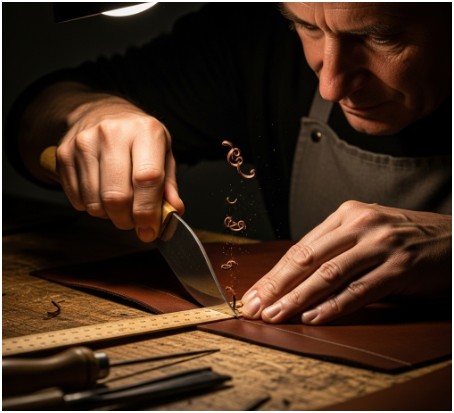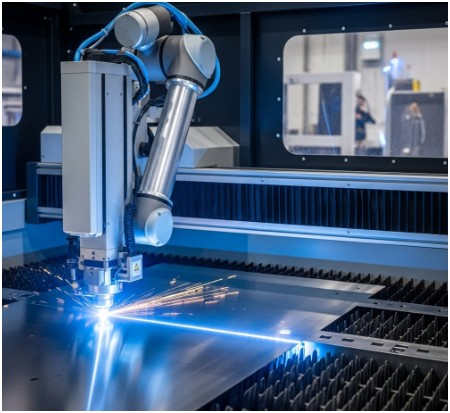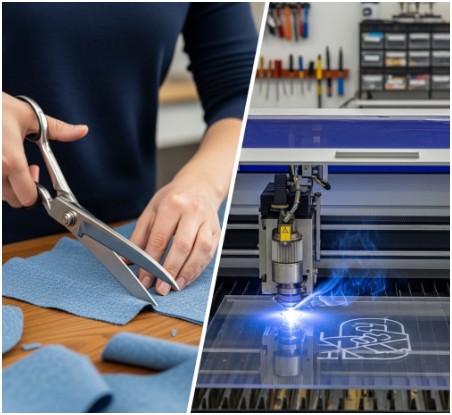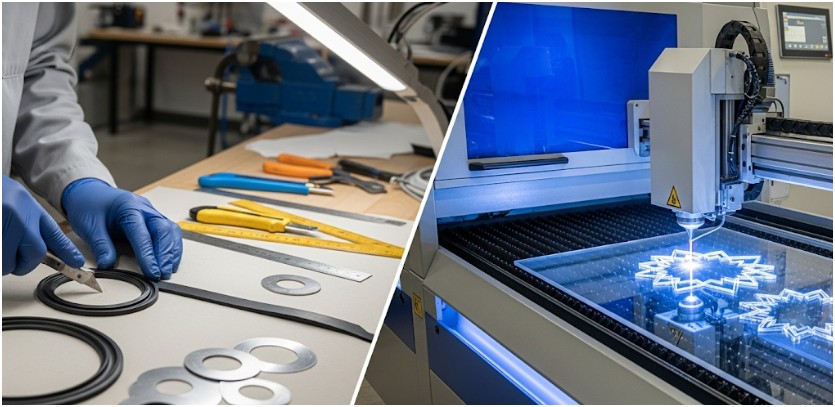Custom seals play a critical role in preventing leaks and ensuring performance in industries like aerospace and automotive.
This guide compares manual and automated cutting techniques, outlining their pros and cons to help you choose the best option for your manufacturing needs.
Manual Cutting Techniques: Traditional Craftsmanship Meets Modern Needs

Manual cutting techniques rely on skilled operators using hand tools and basic machinery to shape sealing materials.
This time-tested approach has sustained many manufacturing operations for decades and continues to offer unique benefits in specific scenarios.
The Advantages of Manual Cutting
Flexibility and Customization
Manual cutting excels when dealing with unique, one-off projects or small batch runs. Operators can easily adapt to design changes mid-production without reprogramming machines or creating new tooling.
This flexibility proves invaluable for prototyping, custom applications, or when working with unusual material specifications.
Lower Initial Investment
Starting a manual cutting operation requires significantly less capital than automated systems. Basic hand tools, templates, and simple cutting equipment can get you operational quickly. This makes manual cutting an attractive option for startups or businesses testing new markets.
Skilled Craftsmanship
Experienced operators bring intuitive problem-solving abilities that machines cannot replicate. They can adjust techniques on the fly, compensate for material variations, and make judgment calls that ensure quality outcomes even when working with challenging materials.
The Limitations of Manual Cutting
Labor Intensity and Costs
Manual cutting demands skilled labor, which comes at a premium. As production volumes increase, labor costs can quickly escalate, making this approach less economical for large-scale operations. Finding and retaining skilled operators also presents ongoing challenges.
Consistency Challenges
Human variability inevitably affects product consistency. Even the most skilled operators may produce slight variations between parts, which can be problematic for applications requiring tight tolerances or when manufacturing large quantities.
Production Speed Limitations
Manual processes inherently limit production speed. Complex geometries or intricate patterns require significant time investment, making it difficult to meet aggressive delivery schedules or high-volume demands.
Essential Tools and Skills for Manual Cutting
Success with manual cutting requires specific tools and expertise. Operators need proficiency with cutting knives, scissors, punches, and dies.
Template creation and measurement skills are crucial for maintaining accuracy. Understanding material properties helps operators select appropriate cutting techniques for different seal materials, from soft elastomers to rigid plastics.
Optimal Applications for Manual Cutting
Manual cutting works best for prototype development, small production runs (typically under 500 pieces), custom one-off projects, and situations requiring frequent design modifications.
It’s also ideal when working with expensive materials where waste minimization is critical, or when dealing with extremely thick or difficult-to-machine materials that might challenge automated systems.
Automated Cutting Techniques: Precision Meets Efficiency

Automated cutting systems use computer-controlled machinery to cut sealing materials with minimal human intervention.
These systems range from simple die-cutting machines to sophisticated laser and waterjet cutters that can handle complex geometries with exceptional precision.
The Advantages of Automated Cutting
Exceptional Precision and Consistency
Automated systems eliminate human variability, producing parts with consistent dimensions and tolerances. This reliability is crucial for applications requiring tight specifications or when manufacturing components that must interfit perfectly.
High-Speed Production
Once programmed, automated systems can operate continuously at speeds far exceeding manual capabilities. This efficiency makes them ideal for high-volume production runs and helps meet tight delivery schedules.
Reduced Labor Costs
While initial investment is higher, automated systems significantly reduce ongoing labor costs. One operator can often manage multiple machines, and the reduced skill requirements for basic operation can lower training costs and improve staffing flexibility.
Advanced Capabilities
Modern automated systems can handle complex geometries, intricate patterns, and multiple operations in a single setup. Features like automatic material feeding, waste removal, and quality inspection further enhance productivity.
The Limitations of Automated Cutting
High Initial Investment
Automated cutting systems require substantial upfront capital investment. Beyond the machine cost, you’ll need programming software, tooling, and often facility modifications to accommodate the equipment.
Setup Time and Complexity
Each new job requires programming, tooling setup, and testing. For small runs, this setup time can represent a significant portion of total production time, making automated cutting less cost-effective.
Limited Flexibility
Making design changes typically requires reprogramming and potentially new tooling. This process can be time-consuming and expensive, making automated systems less suitable for frequently changing specifications.
Types of Automated Cutting Machines
Die-Cutting Systems: Use steel rule dies or solid dies to cut parts through compression. Excellent for high-volume production of simple geometries.
Laser Cutting: Employs focused laser beams to cut or engrave materials. Offers exceptional precision and can handle complex geometries without tooling.
Waterjet Cutting: Uses high-pressure water streams (sometimes with abrasive) to cut materials. Ideal for thick materials and provides excellent edge quality.
CNC Routing: Computer-controlled routers that can cut, drill, and shape materials. Versatile systems suitable for various material types and thicknesses.
Optimal Applications for Automated Cutting
Automated cutting excels in high-volume production runs (typically over 1,000 pieces), applications requiring tight tolerances, repetitive production of identical parts, and situations where labor costs outweigh equipment investment.
It’s also preferred when consistent quality is critical or when complex geometries would be difficult to achieve manually.
Detailed Comparison: Making the Right Choice

Cost Considerations
Manual cutting offers lower startup costs but higher ongoing labor expenses. Automated systems require significant initial investment but provide lower per-piece costs at higher volumes. The break-even point typically occurs between 500-2,000 pieces, depending on part complexity and material type.
Quality and Precision
Automated systems consistently deliver superior precision and repeatability. Manual cutting quality depends heavily on operator skill and can vary between parts. For critical applications requiring tight tolerances, automated cutting is generally preferred.
Production Speed
Automated systems significantly outpace manual methods once programming and setup are complete. However, manual cutting can be faster for very small quantities or when frequent design changes are required.
Flexibility and Adaptability
Manual cutting offers superior flexibility for custom work and design modifications. Automated systems excel at repeating identical operations but require more time and effort to accommodate changes.
Material Compatibility
Both methods can handle most sealing materials, but each has strengths. Manual cutting works well with difficult-to-machine materials, while automated systems can process materials that might be hazardous to handle manually.
Choosing the Right Approach for Your Operation
Several factors should guide your decision between manual and automated cutting techniques. Consider your typical production volumes, required precision levels, budget constraints, and timeline requirements. Also evaluate your current workforce capabilities and long-term business goals.
Many successful operations use a hybrid approach, employing manual cutting for prototypes and small runs while using automated systems for high-volume production.
This strategy maximizes flexibility while maintaining cost-effectiveness across different project types, including the use of EMI RFI shielding materials.
The material types you work with most frequently should also influence your choice. Some materials respond better to specific cutting methods, and understanding these relationships can help optimize your production processes.
Conclusion
Manual cutting is ideal for small-scale, flexible work, while automated cutting offers efficiency and consistency for high-volume production. Evaluate your needs and goals to choose the best option or combine both for maximum value.



